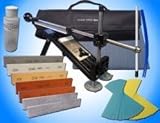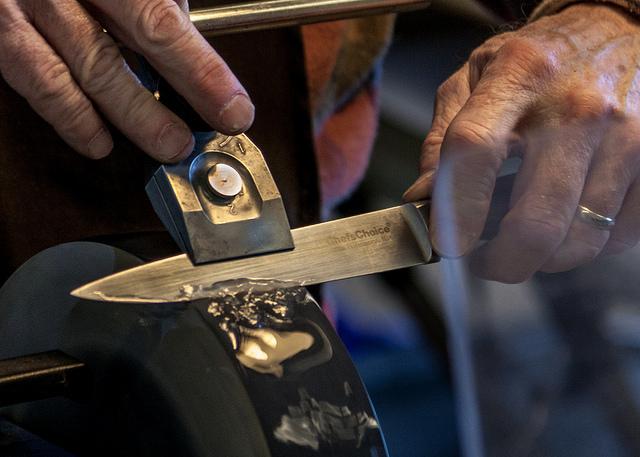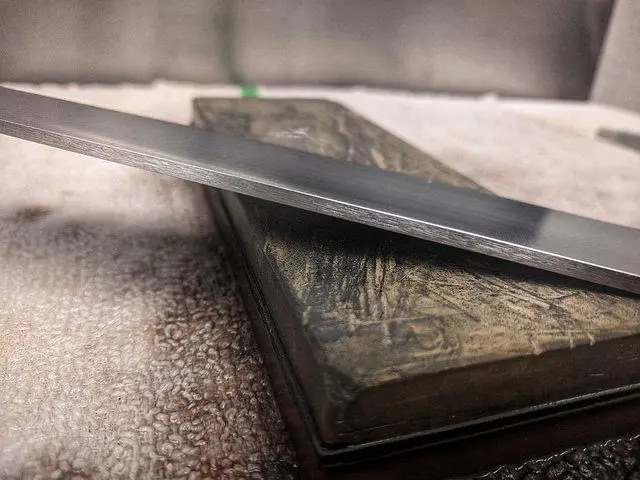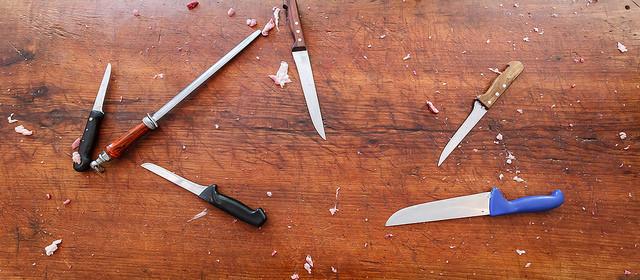(This site is reader-supported. When you buy something using retail links on our articles, we may earn a small commission. As an Amazon Associate I earn from qualifying purchases.)
Source: Paul VanDerWerf
A Dull Knife is Safer!? Well, It Is a Myth!
Any knife requires regular maintenance for retaining its sharpness. It is a misconception that a dull knife is less likely to cut a finger. With a blunt knife, you will have to apply extra force to cut the way you want it. It may result in slipping or cutting your finger. On the other hand, a knife with a well-sharpened edge does not need much force, which makes it more secure.
Our Picks for the Best Knife Sharpeners to Buy in 2024
If you are in a hurry , here is our list of top sharpeners to buy now. If you scroll down to the bottom you can see discussion about these sharpeners.
- Chef’sChoice 1520 AngleSelect Diamond Hone Electric Knife Sharpener – Best to Buy in 2024 for your kitchen knives
- Smith’s 50264 Adjustable Manual Knife Sharpener– Best for Value
- Work Sharp Knife & Tool Sharpener Ken Onion Edition – Best Sharpening System
- Zwilling J.A. Henckels Twin Stone Pro Sharpening Stone– Best Sharpening Stone
- Smiths 50364 X2 Pocket Pal Survival Tool – Best Pocket Knife Sharpener
- Lansky Deluxe 5-Stone Sharpening System – Best Manual Knife Sharpener
- Wüsthof – 10″ Knife Sharpening Steel with Loop – Best Honing Steel
- Presto 08800 EverSharp Electric Knife Sharpener– Best Cheap Electric Knife Sharpener
- Smith’s DRET Diamond Retractable Sharpener – Best for Serrated Blades
- KitchenIQ 50009 Edge Grip 2-Stage Knife Sharpener, Black – Cheap and portable kitchen knife sharpener
- Gerber Bear Grylls Field Sharpener [31-001270] – Best for outdoor, survival, pocket knives
Chef’s Choice 1520

Is the costliest one in this list and also versatile enough to handle American, Asian, and European style knives for restoring both 15 degree and 20-degree angles on respective knives. It features pure diamond abrasives and flexible discs, forming a gothic arch known for its superb sharpness and durability. Features advanced spring guide system for effortless precision-guided sharpening and comes with a 3-year limited warranty. >>Read Our detailed article on Chef’sChoice 1520 here
Check Price and Reviews on Amazon
Smith’s 50264 Adjustable Manual Knife Sharpener

Cheap manual pull through sharpener for wide variety of knives. Features two stage sharpening for serrated knives and standard knives (coarse and fine). It can sharpen knives at angles 14 to 24 degrees. It also features replaceable abrasive components like a soft grip handle and a non-slip rubber feet.
Check Price and Reviews on Amazon
Work Sharp Knife & Tool Sharpener Ken Onion Edition

Heavy duty electric belt knife sharpener with adjustable sharpening guide – from 15° to 30°. Features variable speed motor can handle every sharpening task. It can deliver a long lasting razor-sharp convex edge. It can sharpen scissors, shovels, axes and hatches and importantly made in America. >>Read Our detailed article on Work Sharp Knife & Tool Sharpener here
Check Price and Reviews on Amazon
Zwilling J.A. Henckels Twin Stone Pro Sharpening Stone

Is a double-sided stone meant specifically for sharpening Zwilling J.A. Henckels knives of carbon and steel blades. The dark side is for restoring the shape, while the light side is for normal sharpening. There is no need of soaking this stone. It features 250/1000 grit for medium and rough fine sharpening. There is also a rubber feet for steady sharpening.
Check Price and Reviews on Amazon
Smiths 50364 X2 Pocket Pal Survival Tool

Cheap pocket knife sharpener for your outdoor knives, even more affordable than the Gerber Bear Grylls. It features a tapered diamond rod for grinding serrations and hooks, carbide grit for rapidly setting the edge, and ceramic finishing slot for finishing the edge. The included preset sharpening angles ensure you good results. It comes with a fire starter, Led light, single whistle, and a compass.
Check Price and Reviews on Amazon
Lansky Deluxe 5-Stone Sharpening System

It is capable of sharpening all knives easily with its latest sharpening technology available at some more dollars than the Lansky model. The set offers five sharpening hones, each with a different coarseness, finger groves for safety, and color code, catering to the sharpening needs of all kitchen, garden, and hobby knives. The coarseness options are extra-coarse, fine aluminum oxide, coarse, medium, and extra-fine ceramic. You also get a controlled-angle mechanism with adjustable angle options ranging from 17 to 30 degrees. The set also comes with precision clamp, guide rods, custom-molded carrying case, and honing oil.
Check Price and Reviews on Amazon
Wüsthof – 10″ Knife Sharpening Steel with Loop

Comes with a magnetic steel that attracts metal fibers. It’s cheap and features slip resistant plastic handle.
Check Price and Reviews on Amazon
Presto 08800 EverSharp

It is also affordable but a bit costlier than the above model. It is designed as per North American electrical standards, which makes this model quite reliable at an affordable price. It features a two-stage sharpening system that can handle all non-serrated blades to give out the professional outcome. You get a highly sharp edge in a few seconds via its Sapphirite wheels, the tough material that professional shops tend to use. The precision guides take care of the right sharpening angle every time. The first stage precision grinding is responsible for forming a rightly angled edge. >>Read Our detailed article on Presto 08800 Eversharp Sharpener here
Check Price and Reviews on Amazon
Smith’s DRET Diamond Retractable Sharpener

It’s cheap yet crafted from the highest quality materials. It’s built for performance and durability. It features tapered rod to sharpen serrated knives
Check Price and Reviews on Amazon
KitchenIQ 50009 Edge Grip 2-Stage Knife Sharpener

It is small, portable, compact, easy to use, and perhaps even the most affordable one in this list. It comes with crossed ceramic rods (fine) and carbide blades (coarse) holding sharpening angles that take care of the right sharpening angle every time. Coarse material offers swift edge setting ability, while the fine material in rods ensures final edge honing. The sharpener also features V-grip bottom for using it on a table edge or countertop, soft-grip handle of rubber for stability, and non-slip rubber feet. Well, it is not for serrated blades. >>Read Our detailed article on KitchenIQ 50009 here
Check Price and Reviews on Amazon
Gerber Bear Grylls Field Sharpener [31-001270]

Is cheaper than the Deluxe 5-stone system but demands a bit more than the Blade Medic one. It features a rugged and reliable construction, which is suitable for sharpening military, survival, industrial, and other knives. It is pocket-sized and portable manual sharpener featuring fie ceramic and coarse carbide grits for handling fine blades along with two rod-like diamond-coated mechanisms for serrated blades. The handle is also quite grippy and safe to hold, due to rubber construction. >>Read Our detailed article on Gerber 31-001270 here
Check Price and Reviews on Amazon
Is Sharpening and Honing the Same?
Types of Knife Sharpeners
Manual Knife Sharpener
Sharpening Stones- What to buy in 2024
Source:nullrend
-
Oil Stone: This is the most affordable type of sharpening stone but has a slower cutting rate. The oil is quite messy, but there is no substitute for it if you want a fine finish. Oil stones are usually seen in hardware stores. The Arkansas oil stone is quite popular and comes in various grades. Washita is coarsest and very soft due to which it is avoided. Hard Arkansas is rare and expensive. Soft Arkansas is finer for having a smooth polished edge. The Indian stone made of aluminum oxide is more famous for an excellent finish.
- Water Stone: This is a better option than an oil stone if your priority is quick cuts and easy cleanup. Since it’s made of aluminum oxide, it is very abrasive and soft and will wear away faster. So, you need to flatten it quite often. Water stones are made of natural or synthetic materials, but the natural ones are costlier and rarer to find.
Option:Norton 24335 Japanese-Style Combination Waterstone
- Diamond Stone/Plate: Cleaning such a stone is easy, as it needs only a wire brush that discards shavings and small particles. Such stones are becoming popular because they can cut faster and prevent a recession in the sharpening surface. The durable diamond material has a metal plate holding micro-sized diamonds in it, with or without surface holes. The ones with holes are more popular and capable of sharpening better and faster. You may use the stone dry or wet. It is best to use it wet, as it prevents the diamond abrasive from weighing up with the removed particles.
Option:DMT W6EP 6-Inch Diamond Whetstone Sharpener
- Ceramic Stone: Is a modern alternative but an early substitute for a natural sharpening stone. You can also find them as long rods or sticks with a handle just like sharpening steels or as pre-angled notches. Just like other stones, ceramic is manufactured using minerals. It has a less porous texture. Hence you need to soak it for a few minutes for saturating the pores. The ceramic stones are available at different qualities. A few are extremely soft, while some are quite hard. Because all knife steels tend to differ, you need to choose a ceramic stone suited to your knife. Ceramic stones are a good choice for single-edged knives.
Option:SHAPTON Ceramic whetstone Sharpening stone
- Natural Stone: Is the sharpening stone used widely in ancient Europe and Japan. Good quality natural stone is expensive due to very few operative mines. Natural stones tend to give a lasting edge due to random grits that result in serration of various sizes. You can consider such a stone best for sharpening the Japanese knives having a single bevel.
- Synthetic Stone: It is gaining more popularity than natural stones. It is usually made of fused aluminum grit perched in resin. While a few synthetics demand water soak before use, the rest need a splash. You will find different synthetic stones, including soft steel or firm steel. Consider using an artificial water stone for western-style steel knives. But, some will work nicely on the traditional, single-sided, Japanese edges.
Sharpening Steels – 2024 Picks
Source: Ken Owen
Cuts:
-
Regular cut steels (popular) but are harsher than ceramic ones – Mundial 3303-10 10-Inch Round Regular Cut Sharpening Steel, Black
-
Diamond steels with a layer of diamond abrasives (much like diamond sharpening stones). These are also capable of grinding and recommended for advanced users. if not sharpened cautious, your blade can be damaged – Kota Japan 12 in. Diamond Carbon Steel Professional Knife Sharpener Rod
-
Combination steels featuring a blend of a rough surface for light sharpening and smooth surface for honing –Shun DM0790 Classic Combination Honing Steel Knife Sharpener, 9-Inch
-
Ceramic steels with ceramic material for minor sharpening for finer edge or grinding. 1500 grit rating enough for a sharp edge in up to eight strokes without removing blade metal – Cooks Standard Professional Ceramic Rod Knife Sharpening Steel, 12-Inch
Manual Knife Sharpening Systems
Top Manual Knife Sharpening Systems of 2024
| Image | Title | Price | Amazon |
|---|---|---|---|
 Top
Top
Top
Top
Top
Top | Lansky Deluxe 5-Stone Sharpening System | Check Price on Amazon | |
 Top
Top
Top
Top
Top
Top | Edge Pro Apex 4 Knife Sharpening System | Check Price on Amazon | |
 Top
Top
Top
Top
Top
Top | Work Sharp Knife & Tool Sharpener | Check Price on Amazon | |
 Top
Top | KME Precision Knife Sharpening System | Check Price on Amazon | |
Top Top
Top | Work Sharp Knife & Tool Sharpener Ken Onion Edition | Check Price on Amazon |
Manual Pull-through Sharpener Systems
Top Pull Through Sharpener in the Market
| Image | Title | Price | Amazon Page |
|---|---|---|---|
Top Top
Top
Top
Top | Smith's 50264 Adjustable Manual Knife Sharpener | Check Price on Amazon | |
 Top
Top
Top
Top | Chef'sChoice 4633 AngleSelect Diamond Hone | Check Price on Amazon | |
 Top
Top
Top
Top | AccuSharp 036C Classic Pull-Through Knife Sharpener | Check Price on Amazon |
Electric Knife Sharpeners
Best Electric Knife Sharpeners in the Market
| Image | Title | Price | Amazon Page |
|---|---|---|---|
Top Top
Top
Top
Top | Chef’sChoice 1520 AngleSelect Diamond Hone | Check Price on Amazon | |
 Top
Top
Top
Top | Chef’sChoice 15 Trizor XV EdgeSelect | Check Price on Amazon | |
 Top
Top
Top
Top | LINKYO Electric Knife Sharpener | Check Price on Amazon |
Electric models are more popular than manual stones and manual systems. So, which type is best for your knives? Well, the answer to this depends on the buying factors explained below.
| Type/Feature | Electric | Manual | Stone Systems | Stones |
| Knife Sizes | Larger | All | All | All |
| Speed | Very Fast | Slow | Fast | Slow |
| Precision | Unsure | Somewhat | Very Much | Accurate but only with skill |
| Steel Damage | Yes, tempering | No | No | No |
| Cost | Costly | Affordable | Costly | Broad Assortment |
| Fixed Angle | Usually Yes | Yes | No | No |
How to Choose the Best Knife Sharpener
Now that you know about the different types of knife sharpeners let’s discuss some factors you should consider.
Factor 1 – Types of Knives:
Which knives do you use in the kitchen? If you know this, you know which sharpener is better for you. While all sharpeners are capable of sharpening knives with straight edges, only a few are capable of handling serrated ones. Since serrated knives break down gradually, you might not need a special sharpener if you do not use it often. You will need a special sharpener for sport or Asian-style knives having edge narrower than a regular kitchen knife.
Moreover, if you are choosing an electric or manual sharpener, it is essential to know that some models (regardless of the type) might end up over grinding the knife, which may result in a reduced lifespan of its blade, chipping, and/or warping. To control this issue, consider a sharpener that does not emit much heat and is metal friendly, especially if your knife is expensive.
Factor 2 – Your Patience:
If this is not much within you, an electric sharpener is the best deal. A sharpening stone usually has a long learning curve, although it is easy to use.
Factor 3 – Your Need for Speed:
Consider how you would like how fast you would need to get your sharpening done. Each sharpener performs at a different pace. If you need something that works quickly, a pull-through or an electric sharpener is ideal.
Factor 4 – Type of Blade Bevel
- Convex: Has an outwardly twisting taper that aims to retain more metal at the rear of the edge. This makes the blade stronger while yet maintaining an average level of sharpness. Most cleavers have this kind of bevel. Such a bevel of the edge needs an expert hand on a sharpening stone.
- Hollow: Has an inward taper, which is just in contrast to the convex bevel. This kind of bevel gives an extremely sharp edge, but it is quite fragile. Such a bevel is usually found on straight razors.
- Flat: Has a taper starting at the blade’s spine. Such a bevel is quite sharp, but it is challenging to create due to the quantity of metal to be discarded. This is the reason why such a bevel type is limited in its commercial use.
- Chisel: Features one side as ground down and the other as entirely flat. Such a bevel offers a very sharp edge due to which it is usually seen on Asian cooking knives. Depending upon the side on which the bevel exists, left- and right-handed options are also available.
- Double/Compound: This is usually seen on Western kitchen knives. Another back bevel is added over the edge bevel to boost the cutting ability of the blade. Although not much sharp as other types, the double bevel is admired for its resilience as well as strength.
- V/Sabre: It is much like a flat bevel but with a taper that starts around the blade’s middle area and not from the spine. This kind of bevel is seen on different types of kitchen knives, as it gives a lasting edge.
Factor 5 – Blade Angle
-
12-18: Are for knives that are designed to be very sharp, such as paring. As the angles result in a weaker blade, they usually are considered for models that are designed to perform much of fine slicing. An angle below this range is used explicitly for razors.
-
18-25: Are found on the majority of kitchen knives. The angles in this range make up for a subtle balance between durability and sharpness. These angles are standard on Chef’s knives.
-
25-30: Are seen on many types of outdoor utility knives, such as pocket models. This is because these knives should be able to cut and slice under challenging situations. Hence they need to be durable. So, such knives have a high blade angle.
-
30-35: Are usually seen on cleavers and blades that are specifically designed for chopping. Chopping needs a lot of force that such large-angle blades need to be strong and durable.
Factor 6 – Type of Knife
Factor 7 – Angle Selection
Most Japanese knife makers use hard steel and a lower angle for more sharpness. But, Western blades have a higher angle and made of softer steel. If you have both types of knives, it is essential to choose a knife sharpener that allows you to set different sharpening angles. The knives are designed to perform at its factory bevel angles. It is wise and best to retain them at those angles.
Factor 8 – Number of Stages
Factor 9 – Sharpening Space:
A manual sharpener is ideal if you have space crunch for sharpening. On the contrary, an electric version needs more space.
Factor 10 – Budget:
Usually, several manual sharpeners are cheaper than their electric counterparts. They also cost less to maintain, due to no moving parts that can easily malfunction at some time or the other.
Factor 11 – Noise Level:
Well, for those who do not know, a few electric sharpeners are noisy. There is some kind of scraping sound of the blade, which can be annoying to some people. So, if noise bothers you, check for its noise level.
Factor 12 – Working with Left Hand:
Several manual and electric sharpeners are usable even with the left hand. Make sure that while buying, as some are specifically for right-handed persons.
Qualities of a Good Knife Sharpener
- Superb Sharpness and Performance: The most reliable test of sharpness is to use a knife to slice a tomato. If the knife is nicely sharpened, it should be able to penetrate the skin of a tomato without any effort. A sharpener’s most critical quality is its ability to give a sharp edge without making any scratches.
- Precise and Flexible Angle Guide: A few knife sharpeners allow even a naive to position blade at the right angle. However, many models require all its users to practice a bit. The best sharpener has the best angle guides that are adaptable to embrace several blade angles, precisely 15 and 20 degrees. These two are the most common angles for kitchen knives.
- Abrasive and Hard Surface: Of all the sharpening materials, diamond is the hardest and fastest. Polished ceramic and tungsten carbide follow. Abrasiveness is measured in grits. The higher the number, the finer is abrasive. Thus, a material of 800-grit is very fine, and 120-grit is very coarse.
- Multiple Stages of Sharpening: You need at least two stages — coarse material for restoring dull or damaged edges and finer material for polishing and touch-ups. You cannot use coarse material for touch-ups, as doing so discards too much steel.
- Proper Safety: Usually, it is easy to sharpen without scraping your fingers. In manual sharpeners, this is ensured by inserting a physical blockade between the blade and fingers. Electric knife sharpeners rely on slots to escort the knife into the targeted belt, and not into your fingers.
- Excellent Warranty: This is much needed for an electric sharpener and should also offer prompt and satisfactory customer service.
Best Knife Sharpeners for Pocket/Survival Knives to buy in 2024
- Smiths 50364 X2 Pocket Pal Survival Tool
- Lansky Deluxe 5-Stone Sharpening System
- Gerber Bear Grylls Field Sharpener [31-001270]
Lansky Blademedic Pocket Sharpener PS-MED01

Is perhaps the cheapest and the most portable option for sharpening all outdoor knives, regardless of them having a straight or serrated edge. It is a full sharpening kit with four different features: Diamond tapered rod for quick upkeep and overhaul, tungsten carbide that restores an edge in just three or four strokes, ceramic sharpening rods for polishing a finished edge, and a serrated sharpener to reach up to the smallest serrations.
Check Price and Reviews on Amazon
KME Sharpeners KFS Knife Sharpening System – Standard Stone Kit

It is the costliest one but is also versatile. The kit offers a typical stone kit with rod guide, spring knob, stainless steel guide rod, angle adjustment scale and knob, cherry wood pistol grip, and stone retainer. It has four sharpening stones, each for fine, medium, coarse, and extra coarse grit. It is best for knives that have gut hook and serrations, which are usually toughest to sharpen.
Check Price and Reviews on Amazon
Best Knife Sharpeners for Kitchen Knives
- Chef’sChoice 1520 AngleSelect Diamond Hone Electric Knife Sharpener
- Zwilling J.A. Henckels Twin Stone Pro Sharpening Stone
- Smith’s 50264 Adjustable Manual Knife Sharpener
- Wüsthof – 10″ Knife Sharpening Steel with Loop
Chef’sChoice 320 Diamond Hone

It is an electric, multi-stage unit that is versatile enough to give a 20-degree edge for American and European style knives and a 15-degree edge to an Asian knife. It is also reliable for serrated blades, fine-edge blades, Santukos, sports knives, single-bevel blades, and pocket knives. The sharpener has a three-stage system and precise guides for successful operation. It comes with pure diamond abrasives and flexible discs, durable construction, and stabilizing feet. However, this one is expensive.
Check Price and Reviews on AmazonConclusion

Hi, I am Jay. I am the creator of Knife Guides, your one-stop site for everything related to knives. I am a computer engineer by profession, knife aficionado by passion. Here I work with a group of people who’ve always had a passion for knives and blades. Over the years we’ve kind of become experts and decided to share our knowledge and ideas. I am also an avid hiker and enjoy offshore gamefishing.



